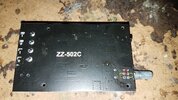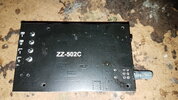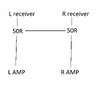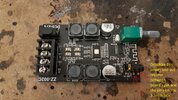SentinelAeon
Member
Amp will be used for videogames, connected through 3.5mm to monitor. I am trying to convert stereo amp into mono but keep the volume knob. pins going in and out of the potenciometer are marked yellow, where i want to join L and R with resistor is marked red. So i am wondering, instead of putting separate resistor on each channel, could i just use 1 to bridge L and R channel (marked with red R) ? It wont be perfect mono, but for video games .., and i at least i protect the channels a bit and get to keep the potenciometer. The potenciometer when turned all the way has 1.2 ohm.
edit: Amp will be connected only through 3.5mm jack, so bluetooth wont be used. Would it be easier to just make mono using the pins around 3.5" ? Desolder the pins and put 50 or 100 ohms on each channel ?
edit: Amp will be connected only through 3.5mm jack, so bluetooth wont be used. Would it be easier to just make mono using the pins around 3.5" ? Desolder the pins and put 50 or 100 ohms on each channel ?






